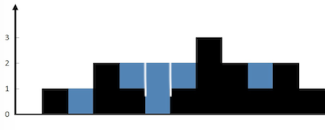Trapping Rain Water 解答
Question
Given n non-negative integers representing an elevation map where the width of each bar is 1, compute how much water it is able to trap after raining.

The above elevation map is represented by array [0,1,0,2,1,0,1,3,2,1,2,1]. In this case, 6 units of rain water (blue section) are being trapped. Thanks Marcos for contributing this image!
Example:
Input: [0,1,0,2,1,0,1,3,2,1,2,1] Output: 6
Solution 1 -- DP

关键是将问题转换成求和,考虑每一个格子的可以贡献的水量。如上图所示,每一个格子上可以储存的最大水量由它左右两边决定。
volumn = min(max_left, max_right) - height
所以我们可以用DP来算出每个格子的max_left和max_right,进而可以得到总的水量。
1 class Solution: 2 def trap(self, height: List[int]) -> int: 3 if not height: 4 return 0 5 L = len(height) 6 dp_right = [height[0]] + [0] * (L - 1) 7 dp_left = [0] * (L - 1) + [height[L - 1]] 8 result = 0 9 for i in range(1, L): 10 dp_left[i] = max(dp_left[i - 1], height[i - 1]) 11 for i in range(L - 2, 0, -1): 12 dp_right[i] = max(dp_right[i + 1], height[i + 1]) 13 tmp = min(dp_left[i], dp_right[i]) - height[i] 14 if tmp > 0: 15 result += tmp 16 return result
Solution 2 -- Two Pointers
双指针法,一次遍历。
1 class Solution: 2 def trap(self, height: List[int]) -> int: 3 if not height: 4 return 0 5 l, r = 0, len(height) - 1 6 result = 0 7 while l < r: 8 tmp = min(height[l], height[r]) 9 if height[l] < height[r]: 10 l += 1 11 while l < r and height[l] < tmp: 12 result += tmp - height[l] 13 l += 1 14 else: 15 r -= 1 16 while l < r and height[r] < tmp: 17 result += tmp - height[r] 18 r -= 1 19 return result


